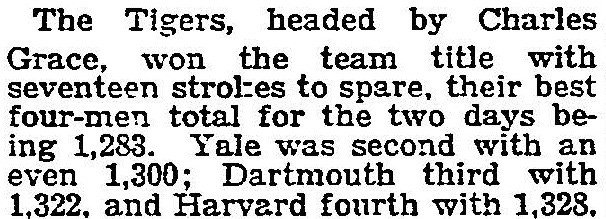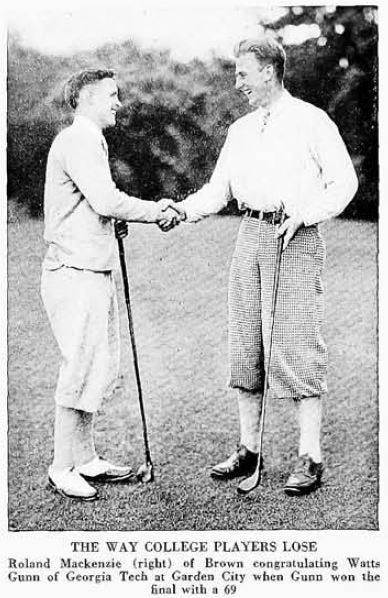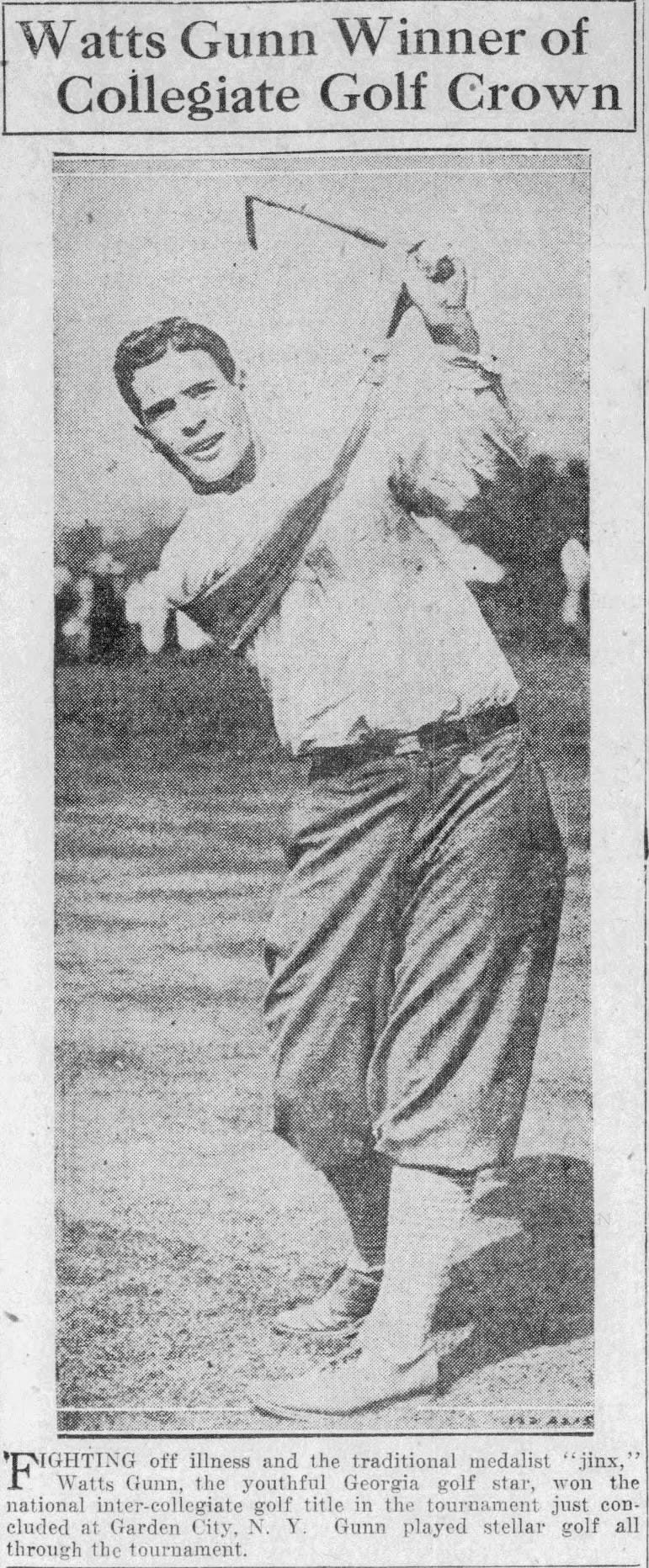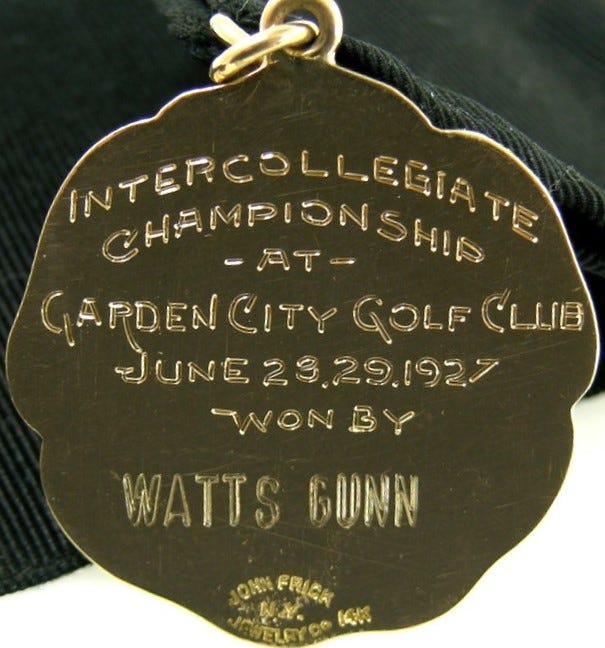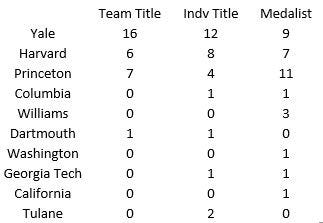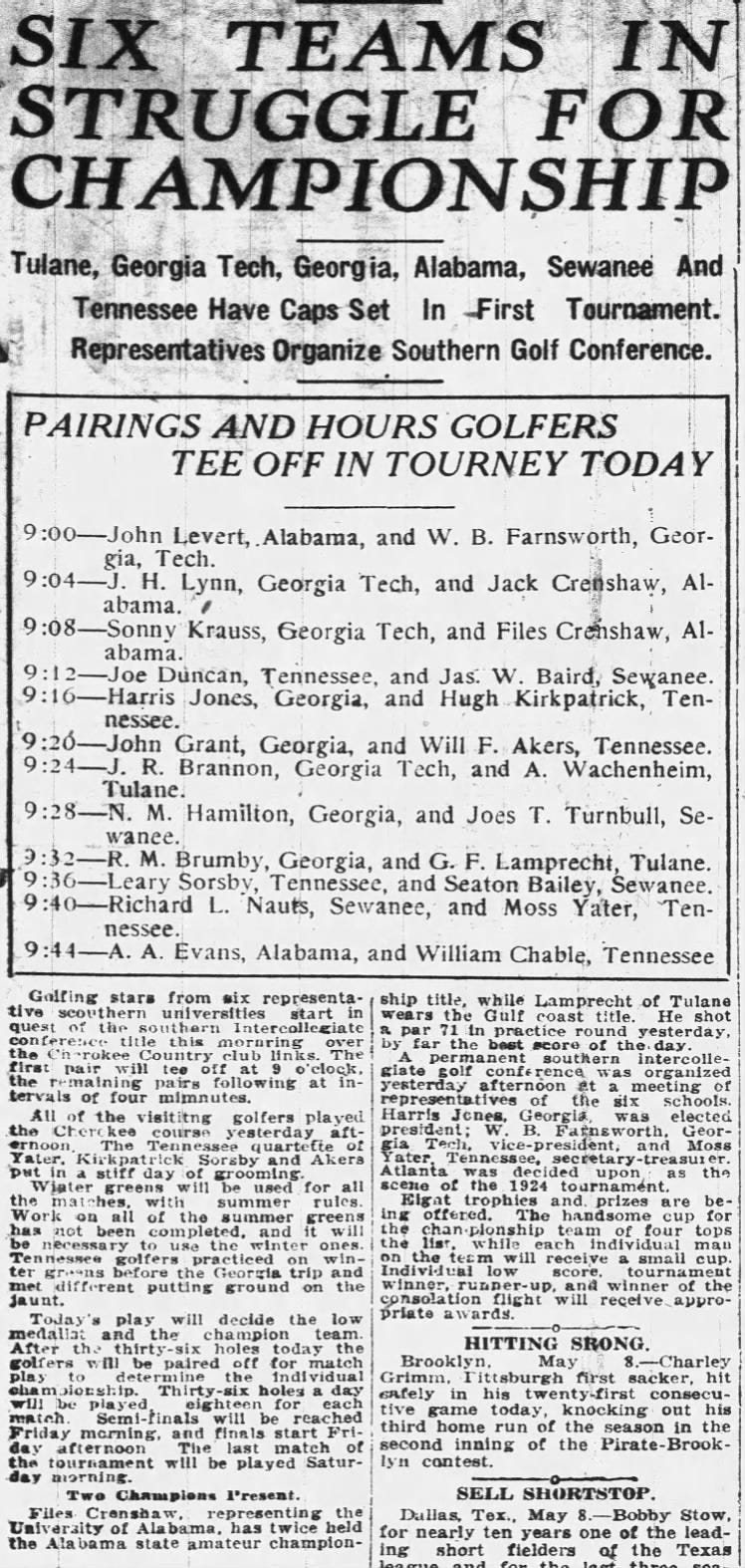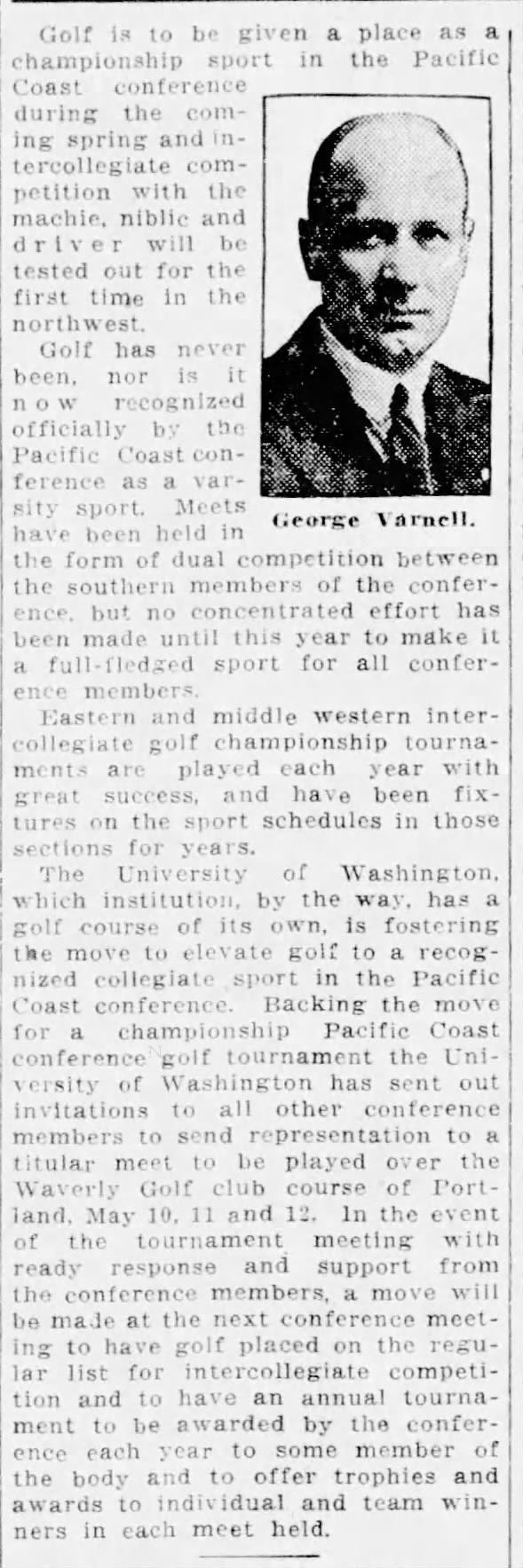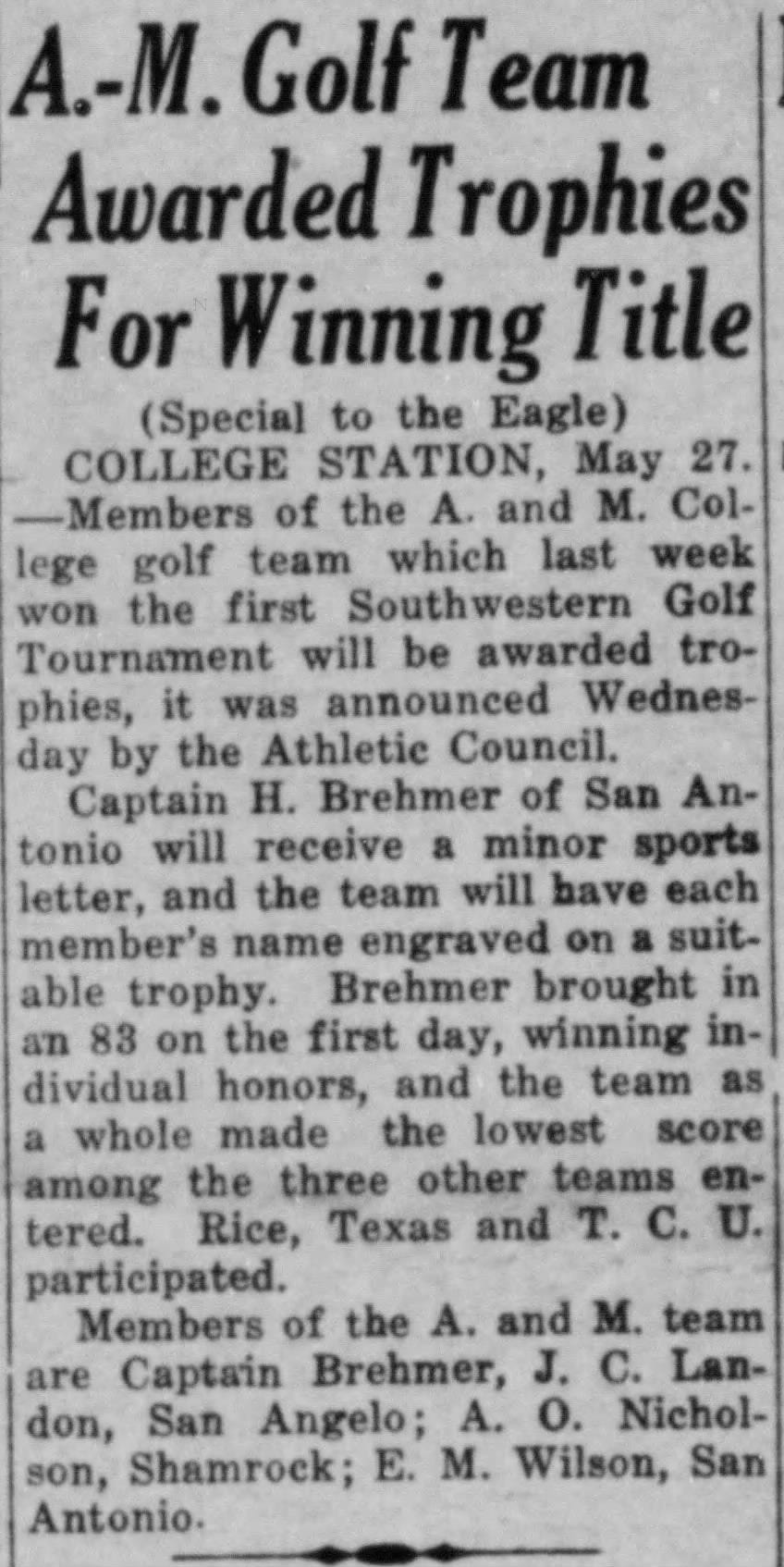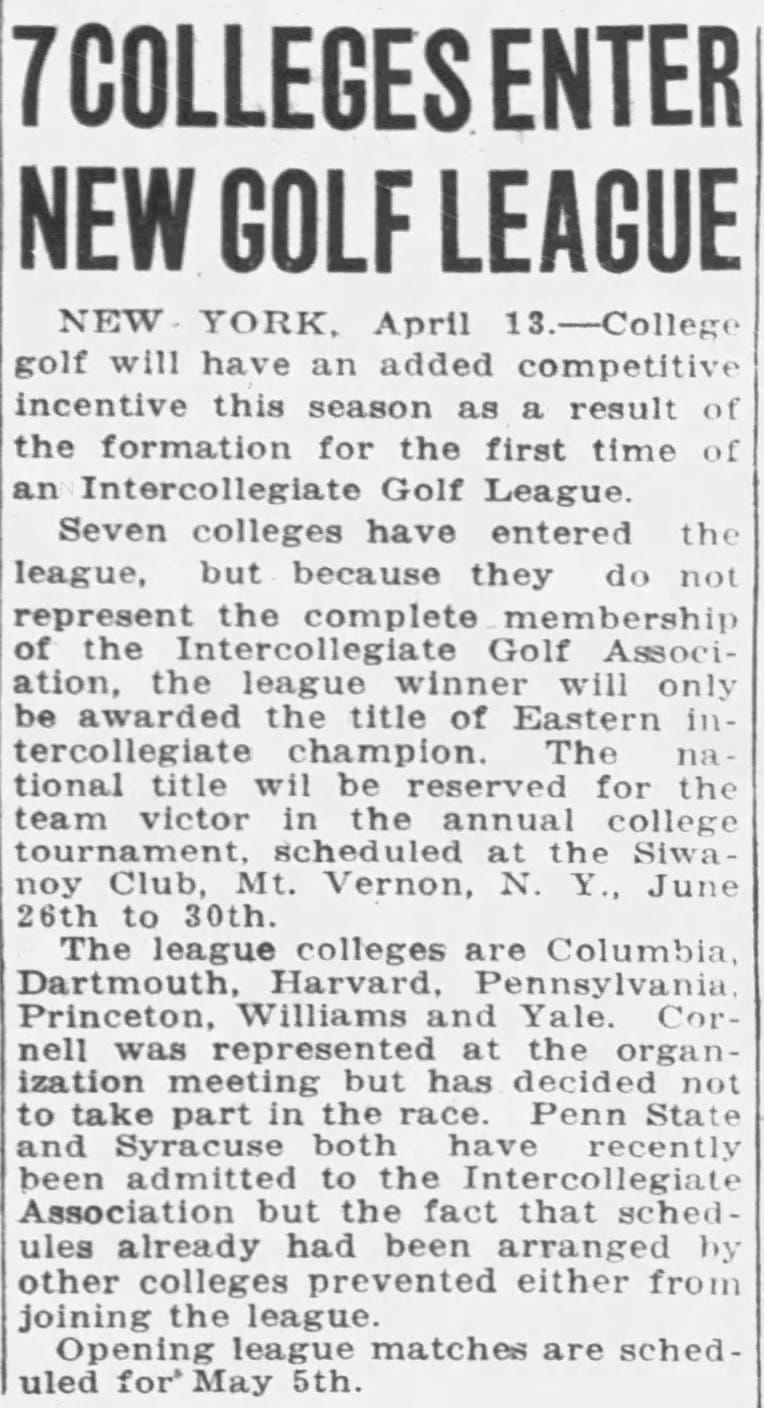This is part of a series on the Men’s Collegiate Championships
IGA Championship Era: 1897-1938
Bobby Jones is four years removed from being a Georgia Tech undergrad and now not only are there teams playing which might or might not have been IGA members such as NYU and Union, there were also individuals playing for teams who were not represented in the team championship (again, unclear if they were even IGA members) including: Brown, Minnesota, Stanford, Lehigh, Amherst, West Point, and Colgate. The world of college golf is opening up as the tournament is represented in one way or another from practically coast to coast. In the field as an individual in another Georgia Tech sensation looking to capitalize on the opportunity.
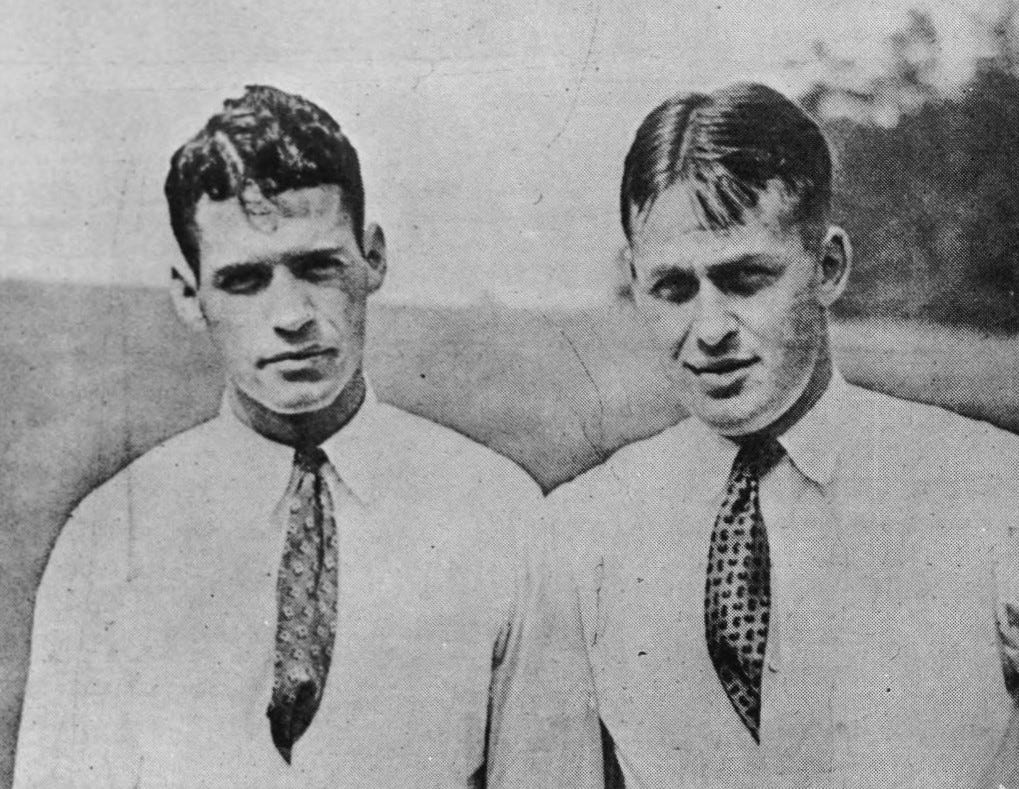
Intercollegiate Championship #30: June 29 - July 03, 1927
Host: Garden City CC
Princeton won the last two times that Garden City hosted the tournament, in 1914 when they won their first and again in 1922 when they won their 5th. The club recently played host to the 1924 Walker Cup where team USA - captained by Robert Gardner and included Bobby Jones and Jess Sweetser - defeated GBI in the last matchup before it became a biannual event.
Format
Team stroke play
**Two major changes used for the first time
All stroke play holes will count towards both the team title and the individual qualifying
6-count-4 format: (up to) SIX team members are selected with the low FOUR scores **after all rounds are played
Day 1 = 36 holes
Day 2 = 36 holes
**NOTE: after this team championship the newly elected IGA leadership voted to reduce the team (and individual qualifying) portion down to just 36 holes
Individual match play (32 players, random draw, 18 hole matches)
Results
Team Champ: Princeton (7)
After a three year drought, Princeton gets back to their winning ways with a 17 stroke victory over Yale. This new 6-count-4 format would prove very good for Princeton who would win the next 3 tournaments, culminating with a victory (their 10th) at Oakmont in 1930, the site of their 1916 (2nd ever) championship.
Medalist: Watts Gunn [Georgia Tech]
Both Watts Gunn and Roland Mackenzie (Brown) are 1926 Walker Cup alums who missed the previous year’s collegiate championship to play alongside Bobby Jones, Jess Sweetser, and other top American amateurs in the narrow victory against the GB&I team at St Andrews. Aside from Gunn’s 72-hole scores of 302 - which narrowly edged out Mackenzie and Big Ten champ Lester Bolstad (Minnesota) - the most exciting occurrence during stroke play was Harvard’s captain Edward Stimpson shooting a third round 71 to set the record low for the newly remodeled course.
Individual Champ: Watts Gunn [Georgia Tech]
A combination of the grueling tournament and a bout of “toxic poisoning” took its toll on Watts Gunn, yet he still managed to reach the Finals where he met none other than his Walker Cup roommate, Roland Mackenzie. Some wondered if Gunn would be able to handle the 36-hole final match, but they shouldn’t have worried as it turned out to only last 27 holes. Gunn’s morning four under par 69 was a competitive course record (match play only?) and although both competitors’ scorecards read 38 in the afternoon 9 the match was concluded with the final score an astounding 10&9. With the champion from the previous two years being Fred Lamprecht of Tulane, this marks the third consecutive year that the title made its way South to the undoubted ire of all.
That Gunn was Bobby Jones’s protégé was well publicized coming into the tournament, with one newspaper dubbing him the “Georgia Peach”. The two had met competitively a few times with the most prominent being in 1925 US Am Finals at Oakmont where Gunn def Sweetser on the way to the Finals which he ultimately lost to Jones. Both were on 1926 (St. Andrews) and 1928 (Chicago GC) Walker Cup teams, and long time members of the East Lake Golf Course. Gunn wouldn’t be the only East Lake protégé of Jones’s who would make history at the collegiate championships.

Championship Award Count
EXTRA HOLES: The Stimpmeter
Harvard senior, captain Edward Stimpson wrapped up both his collegiate golf career and stint as IGA President at the 1927 championship. Though his playing career would not take Mr. Stimpson to the height of fame, another contribution to the game of golf ultimately would. The story goes that Mr. Stimpson was inspired by the inconsistent putting at the 1935 US Open at Oakmont (which he might or might not have seen in person) to create a device which would help measure the speed of the greens and thus provide a way to make them more consistent. Though it took many years to convince the USGA (and others) to adopt the use of the device, it now is an invaluable tool used for both competition and every-day use on golf courses everywhere. The USGA provided a pamphlet that goes into more detail on the history and use of the device that has since gone through a couple of changes.
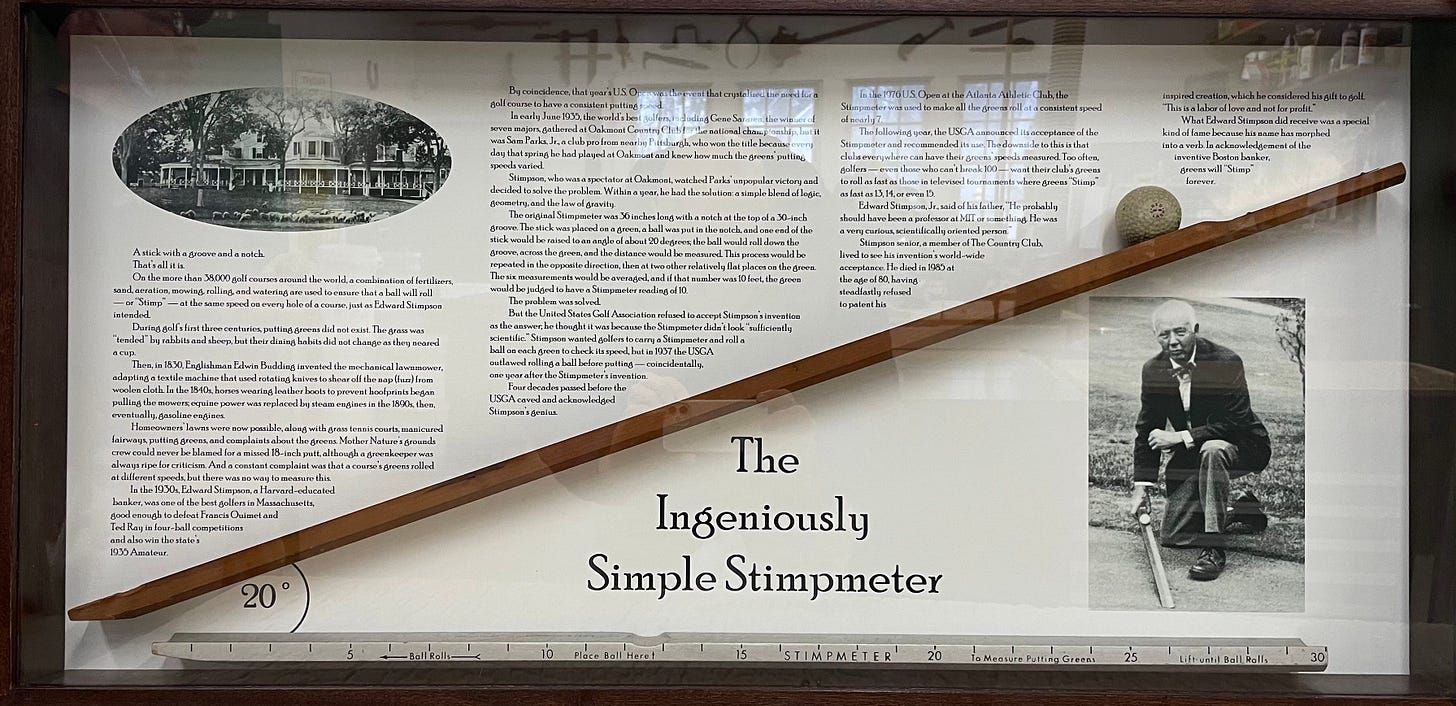
EXTRA HOLES: Conference Golf
In the last post we discussed the beginnings of collegiate conference golf with the start of the Big Ten and Missouri Valley conferences. The latter was discontinued from 1926-1934, but the former had only grown in prestige and importance. It wasn’t long before other conferences, known primarily for football, baseball, and/or track, would pick up golf too. We intend to cover these more in depth in a separate post at some point to give this topic proper justice, especially considering the first would birth TWO major Power 5 conferences.
Southern Intercollegiate Conference (SIC)
Now known as the Southern Conference (SoCon), the SIC was born in 1921 when a large number of colleges split from the Southern Intercollegiate Athletic Association. In early 1923, Moss Yater from the University of Tennessee organized what was unofficially the first SIC golf tournament, won by Georgia. The next three years were dominated by a newly created (1923) University of Alabama team which won team and most individual titles. The major competitor coming out of the SIC, however, was Tulane’s Fred Lamprecht. Through a special arrangement starting in 1924, the IGA allowed most of the individual SIC finalists each year to compete in the national championship. Lamprecht, who won the SIC in 1925 over Bama’s Bobby Baugh, shocked everyone to win not only the individual IGA championship in 1925 but repeating the next year. Georgia Tech finally wrestled away the team championship from Alabama in 1927 than in large part to their leader, and individual SIC champion, Watts Gunn, who would go on to do more of the same on the national stage. According to the SoCon record book, the first official championship wasn’t until 1930 (won by Alabama which included medalist Sam Perry), however the conference had already made a tremendous impact on the college golf history.
Pacific Coast (PCC)
Before the official start of the PAC-10/12 (1960 according to the record books), there was another Pacific Coast Conference which did not recognize golf as a conference sport when University of Washington’s Arthur Gerbel sent out invitations to foster a more collective golf tournament - as opposed to the dual matches played between some of the universities. Only Washington and Oregon showed up for this “tournament”, which devolved into 2-man matchups, but even still the move caused golf to join the list of recognized sports in the conference. The next several years involved a confusing mix of events held in Southern California (at Pebble Beach in February) and someplace north around May. Winners from these events included players who would make a splash at the IGA championship by taking medalist honors - Lauren Upson [California] in 1924 and Jack Westland [Washington] in 1926. The first “Pacific Coast Intercollegiate”, which would be the first semblance of a true conference championship, was held in 1928, but the financial hardship across the country in the early 1930s would hamper teams from truly competing for either a conference championship or making a major showing at the IGA championship.
Southwest (SWC)
The SWC has an extremely interesting history that has a direct impact on a couple of major college conferences today, namely the Big 12. Golf started for the SWC in 1926 where Texas A&M stole the show winning both team and individual honors. The next two years belonged to the University of Texas, coached by Tom Penick, the older brother of legendary Harvey Penick. It would still be a few more years before SWC teams would make an impact on the national tournament.
Intercollegiate Golf League (IGL)
As the national IGA championship opened up to more teams across the country, many of the original schools decided to form together their own regional group for play during what might be considered the regular season. In 1923, seven of the IGA members formed the IGL: Yale, Columbia, Harvard, Princeton, Penn, Dartmouth, and Williams. The IGL was expanded in the early 1930s to 12 teams and rebranded as the Eastern Intercollegiate Golf Association (EIGA). This would eventually became the Ivy League, and according to the record book the first official champion was Princeton in 1928. The winner of the conference now earns possession of a beautiful trophy once given to John Reid Sr. in 1910 and later donated by the family.
Thanks for reading!
Up Next:
In the next post we will cover the 1934 championship which marks a major turning point in the IGA championship being considered a true “national” event as Michigan - led by a coach with a killer name - does the unthinkable. Plus, you better believe there are some incredible ties between college golf and the first Masters.




